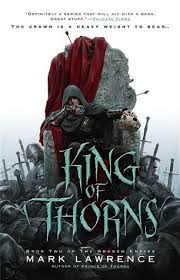
2‑King of Thorns
Chapter 20: Four years earlier
by Mark, Lawrence,The chapter “19: Four Years Earlier” serves as a flashback, providing critical context for the events unfolding in *King of Thorns*, the second book of the Broken Empire series. It delves into the protagonist’s past, revealing formative experiences that shaped his ruthless and strategic mindset. The narrative shifts to a time before the current conflicts, offering insights into the protagonist’s earlier struggles and alliances. This temporal shift underscores the complexity of his character and the origins of his ambitions.
The flashback explores key moments that define the protagonist’s trajectory, including pivotal battles and personal losses. These events highlight his resilience and cunning, as well as the moral ambiguities that accompany his rise to power. The chapter contrasts his past innocence with his present ruthlessness, illustrating how trauma and betrayal have hardened him. The interplay between past and present deepens the reader’s understanding of his motivations and the empire’s fractured state.
Relationships and rivalries from four years earlier are revisited, shedding light on alliances that still influence the current narrative. The protagonist’s interactions with allies and enemies reveal the seeds of future conflicts and betrayals. The chapter emphasizes the cyclical nature of power and vengeance, as past decisions continue to reverberate. These dynamics enrich the story’s tension and foreshadow upcoming confrontations.
Ultimately, the chapter serves as a bridge between the protagonist’s past and present, weaving together the threads of his journey. It reinforces themes of power, survival, and the cost of ambition, while setting the stage for the next phase of the Broken Empire’s saga. The flashback not only adds depth to the protagonist but also heightens the stakes for the ongoing narrative, leaving readers eager to see how his past will shape his future actions.
FAQs
1. What is the significance of the chapter title “19: Four years earlier” in the context of King of Thorns?
Answer:
The chapter title “19: Four years earlier” indicates a flashback or temporal shift in the narrative, providing crucial background information about events that occurred four years prior to the main timeline. This structural choice allows the author to develop character backstory, reveal formative experiences, or explain motivations that influence present actions in the Broken Empire saga. While the provided excerpt doesn’t contain specific content, such titles typically serve to deepen reader understanding of how past events shape the current political landscape and personal conflicts in dark fantasy settings like this one.2. How might the narrative structure of jumping between timelines (“Four years earlier”) enhance the storytelling in a grimdark fantasy like King of Thorns?
Answer:
The alternating timeline structure serves multiple purposes in grimdark fantasy: it creates suspense by gradually revealing how past events led to the present situation, allows for dramatic irony where readers know more than characters, and enables complex character development by showing transformation over time. In King of Thorns specifically, this technique likely highlights Jorg Ancrath’s evolution as an antihero, contrasting his past actions with current consequences. The temporal shifts also mirror the fractured nature of the Broken Empire’s world, reinforcing themes of fragmented power and unstable realities common to the genre.3. What challenges might an author face when writing a chapter that occurs significantly earlier than the main timeline, and how could these be addressed?
Answer:
Key challenges include maintaining narrative cohesion, ensuring timeline consistency, and preserving character voice while showing development. The author must carefully plant clues that connect past events to the present story without being heavy-handed. Effective solutions involve using thematic parallels, recurring motifs, or objects that bridge timelines. Dialogue and narration style should reflect the character’s younger perspective while remaining recognizable. The chapter must advance the overall plot or character arcs rather than simply providing exposition, making every revealed past event consequential to the present narrative.4. In what ways could a flashback chapter (“Four years earlier”) fundamentally change readers’ understanding of a protagonist like Jorg Ancrath?
Answer:
A well-crafted flashback chapter could humanize Jorg by revealing formative traumas or motivations behind his ruthless exterior, or alternatively, show earlier instances of his inherent brutality to confirm his nature. It might expose pivotal choices that set him on his path, relationships that shaped his worldview, or events that explain his current alliances/enmities. For a complex antihero, such revelations can force readers to reconsider whether his actions stem from circumstance or character, potentially shifting audience sympathy. The chapter could also contain ironic moments where Jorg’s past intentions contrast sharply with their outcomes four years later.
Quotes
1. “Memory is all we are. Moments and feelings, captured in amber, strung on filaments of reason. Take a man’s memories and you take all of him. Chip away a memory at a time and you destroy him as surely as if you hammered nail after nail through his skull.”
This quote captures the philosophical core of the chapter, emphasizing the fragility and importance of memory in shaping identity. It reflects the protagonist’s introspective view on how memories define existence.
2. “The dead are only dead if they die in your heart. In your head they live, laughing, loving, lying.”
A poignant reflection on grief and the persistence of memory, this quote illustrates how the past continues to influence the present. It underscores the theme of emotional ghosts that haunt the living.
3. “A man who can’t bear his past is no man at all. The past is what you stand on, like a rock in the sea. Let it go and you’ll drown.”
This powerful statement ties into the chapter’s exploration of confronting one’s history. It represents the protagonist’s belief that accepting and owning one’s past is essential for survival and strength.
